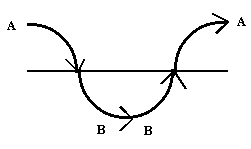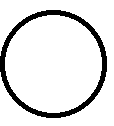PROLOGUE
The Eternal Return
Jesus said to them:
When you make the two one,
and when you make the inner as the outer
and the outer as the inner
and the above as the below,
and when you make the male and the female
into a single one
. . . then shall you enter [the Kingdom].1
The
Gospel According to Thomas
Encountering the Spirit of Truth
The realm, the reign, the domain of God—the One, the All, the Whole—is neither "here nor there." Rather, Jesus announces, it is "among you" and "within you." And like God, like light, like consciousness, it is everywhere and in every moment "at hand."
The above passage from The Gospel of Thomas proposes that life in the spiritual or eternal realm comes about through a change of perception by which the two become one. Through a transformation of consciousness, matter and spirit, heaven and earth, even life and death are no longer seen as in opposition but as the interchangeable "one stuff" of all that is
—now matter, now spirit.Except for the language of symbolism and the capacity of consciousness to handle paradox, the all-encompassing, all-pervasive greater Reality in which all live and move and have being would defy description. Except, also, for the images evoked by analogy and metaphor, our linearly strung-together words would render us all "flatlanders," with no means to conceive the heights and depths of consciousness that we as creatures share with the Creator.
It is as though in order to enter the realm of divine consciousness a special way of thinking is required, perhaps what Paul intends by "put[ting] on Christ,"2
or by having "the mind of Christ" within.3 It also may be why Jesus never put his teachings into writing, leaving instead his life as witness and therefore a question each one, ultimately and individually, must address: "And who do you say that I am?"The differing perspectives of the New Testament are, in fact, an invitation to draw our own conclusions. Nor do factual discrepancies in any way obscure the essential message of the way, that is to say the path, that leads to Life. Through parable, paradox and personal interaction, the intent is clarified: to awaken the slumbering spiritual mind in order to engage the seeker of truth in a dialogue with the Spirit of Truth.
For Paul "the mind of Christ" is the means through which the living Spirit communicates. Paul knows this experientially, and knows this inner spirit in him as the agent of transformation and therefore his "hope of glory."4
Similarly, the imago Dei is for Jung the imprint of the divine on the soul. Thus Paul’s inner Christ and Jung's transcendent Self are closely linked. Based on this premise, Jung can say:Christ exemplifies the archetype of the self.5
As the Gospel of Thomas gives the formula for entry into the spiritual realm as "making the two one," so Paul offers "putting on the mind of Christ" as how it is done. From self-honest observation he knows what it is to be "in the flesh" one minute and transported to "the third heaven" the next.6
Much of early childhood is also spent in and out of two worlds. Observed as being "at play," the child is said to be "lost in imagination." In reflecting back to his own childhood, Wordsworth recalls how his memories of heavenly realms gradually faded, but how later in life were again experienced in moments of "inspiration." Some scientists, as well, experience their "breakthroughs" as coming from higher levels of consciousness. Heightened realms are where mystics go as well for the purpose of keeping God company and for receiving guidance. Having solved the riddle of how "to make the two one," they know the escape route around the "Tree of Good and Evil"—how, that is, to bypass the mind-brain’s bi-lateral duality by going through the Christ "door" into the unitive presence of God.
The Eternal Spiral Return
The journey away from and back to unitive consciousness is divided into three parts: a move outward from an original "garden" state of undifferentiated unity; into a "wilderness" of alienation and separation; to a point of extremity where the soul begins its journey back to its Source.
Dante’s vision of the heavens ends in a reunion with "the Love that moves the sun and the other stars." His culminating image is an immense, spiraling "Celestial Rose" of radiant beings who, having completed their own journeys, now serve as the attracting center to which all souls are being drawn into harmonious relationship as integral parts of the Whole. In contrast, his image of the "deepest" hell is of souls encapsulated in ice—in a state of absolute isolation. The movement from one state of consciousness to the other is the soul’s journey to an ever-widening, expansive perspective of the Whole. Symbolic of consciousness itself, Dante’s sun is the Self born out of the heart of God and now returning fully conscious of having been present "when the stars began to shine."
Comparing the Divine Comedy to the epic works of other world religions, Joseph Campbell singles it out as the only complete and systematic symbolism Christianity can claim as wholly its own. In a seminar on death and rebirth symbolism, he noted the universal significance of the three-and-one-half spiral as the master motif of the soul’s journey. As the Eternal Spiral Return it is the path of life—of heart, mind and soul. From birth to mid-life, the spiral moves out, expanding and extending until it reaches the mid-point where the direction is reversed and the journey outward now turns back inward—the soul back to its Source. (Figure 1)
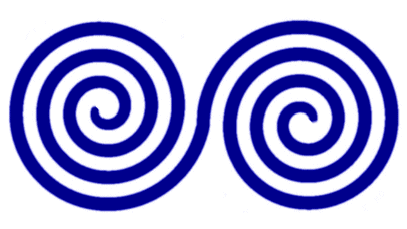
The Eternal Spiral Return
Figure 1
If the inner journey has kept pace with one’s outer life, the lessening of physical energies is compensated by an expansion of heart and a widening of consciousness that is coming to know existence as a seamless Whole. This higher perspective is what is meant by transcendent consciousness—the knowledge and experience of the All as an integral Whole.
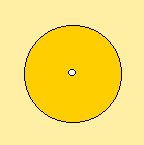
Figure 2a
Sun as Ego
Paradoxes of the Self
Because transformation is a process involving communication between different levels of consciousness, each step up or down sometimes seems at odds with the one above or below. In moving in a perpendicular rather than parallel direction, the laws or "rules" governing one level can appear contradictory to the next. In reality both views are valid but paradoxical. An example is the ego’s function as the center of the ordinary, everyday conscious mind. Its perspective is from a highly subjective point of view around which it draws a circle and chooses what to include and what to exclude. Its criterion is what supports or what threatens its survival or adaptation. Its symbol is the point-centered-circle, identical to the glyph for the sun. (Figure 2a) But this same sign of the ego’s limited field of consciousness also stands for gold. And gold is symbolic of the Self—the inner Christ—who, like the sun, radiates light freely and expansively to all. (Figure 2b) This distinction between ego and Self—the one self-containing, the other self-giving—is better communicated through images than words.
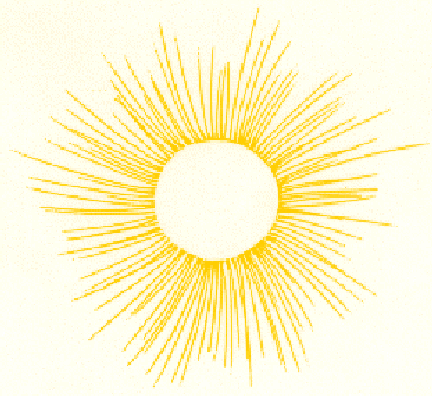
Figure 2b
Sun as Self
Symbolic Inversion as Paradox
Also applicable to the overall transformation process is the law of symbolic inversion. An example may be observed in the second half of life when, for the ego, the process is reverse that of the first. Instead of building walls of separation, it must now begin tearing them down. Now "the way down" becomes "the way up." This paradoxical manner of thinking is crucial to understanding such sayings of Jesus as "to save your life you must lose it." Except for the mental gymnastics a paradox requires, much in the Gospels attributed to Jesus would be passed over as incomprehensible, while from the perspective of depth psychology they make perfect, if "illogical," sense. Edinger notes that since "paradoxes point to the Self"
7 they provide insight into the progression of the journey.Coming to Terms with Destiny
In demonstration of how the higher perspective of the Self can be usurped by the ego, Jesus asks "Who do you say that I am?" It is Peter who answers, "The Christ . . . the son of the living God." For this answer Jesus commends Peter, telling him, "Flesh and blood has not revealed this to you but my Father who is in heaven."
8 Then right on the heels of Peter’s high moment of revelation he says something so utterly natural-minded that Jesus rebukes him with the shocking, piercing words, "Get behind me Satan." We cringe, knowing the words are not for Peter alone. We too are of two minds and therefore subject to ego inflation one minute and deflation the next.Commended for his spiritual perception, Peter’s ego intercepts the praise. But it is even more complicated. For a moment Peter really does see through flesh to spirit, really does understand the divine nature of the destiny to which Jesus is called. The Master therefore attempts to prepare him for the inevitability of his crucifixion. But Peter won’t hear what he doesn’t want to hear. He is rebuked because he can’t bear the thought of Jesus not being there for him. Such personal loss is more than he can comprehend.
Peter is in denial, and for this reason he needs to be shocked back into his spiritual mind. He needs to be shocked out of his opposition to the very thing that Jesus, perhaps at that very moment, has been struggling to come to terms with: that those who oppose the truth and inner authority out of which he has been living, speaking and acting are plotting to kill him. After the fact, there would be those who would read into his death the sacrificial appeasement of an angry god. But from a Jungian perspective, the cross can be understood as the supreme symbolic expression of the reconciliation of opposites, and the crucifixion as sublimely synchronistic in its meaningful coincidence with the central message of Jesus' life:
that in order to find the larger meaning of Life, the lesser must die. Also vital to understanding the cross as a process the human psyche must undergo in becoming whole, is the conjunction of its vertical and horizontal lines in order to establish a center around which the soul's fragmented parts can be unified, can be reconciled, can become "the Love that moves the sun and the other stars." Fully cognizant or not of his destiny to become this center, Jesus "sets his face towards Jerusalem" knowing what awaits him there. When Peter tries to dissuade him, he calls Peter's attempted hindrance "Satan."But Peter also has a divine destiny, and only in releasing Jesus to fulfill his can Peter release himself to fulfill his own—to be who he is and do what only he can do. Moreover, what is true for Jesus and what is true for Peter is also true for us. We discover our destiny in each moment we see with clarity who we are and what only we can do.
Asking and Receiving
When "I" (and the "I" can be any one of us) ask: "What is the purpose of my life?" "Why am I here?" "Why now?" the search is for the answer to the ultimate question—Who is God/Who am I? The "I" who asks the question is the seeker of truth, and the one who answers is the Spirit of Truth.
Who asks receives,
who seeks finds,
to whomever knocks,
it will be opened.9
Even though I read Tillich’s Systematic Theology thirty years ago, one statement remains engraved in my mind:
You cannot receive the answer to a question you have not asked.
Yet answers come to each in different ways: to some as flashing insights, to others as mere flickering glimpses; to some as audible voices, and to others as faint whispers. Regardless of how, a law of spirit would seem to indicate that a question sincerely asked will receive an answer. Is asking how the seeker in each of us knocks at the door of the spiritual realm?—a door just waiting for an opening into the conscious mind of the seeker.
The "U-Turn" of the Journey
Once when Hebrew scholar Carlo Suar
as was meditating on The Gospel According to Thomas, the Spirit of Truth in the person of Rabbi Jesus said to him:While you were seeking that which was yours and finding that what you had thought was yours was to others; while you were naming those things and thereby expelling them; in the empty spaces that they left in you, as small perhaps as a mustard seed . . . in those voids, little by little, the Kingdom penetrated in you.10
Through Carlo’s inner dialogues with "Reb Yhshwh" he came to understand that in the full cycle of life’s journey there is a turning point—a "U-turn"—where the original process of building and supporting a framework turns into a process of freeing itself from its structures.11
Building Up and Knocking Down
With the task of the first half of life being to build a support system for the ego of sufficient strength to withstand the perils of the journey, so the task of the second half of life is to dismantle what so carefully has been built.
When my children were small they would pile their blocks into what I called their "towers of Babel," all the time anticipating the moment of delight when they would knock it all down. So it is with the ego: all that it has built will someday come crashing down. When this happens it signals the ego’s approaching transformation from the lesser light of consciousness to its higher function of linking the conscious mind to the greater light of the Self. Also to be heard amid the din of the ego’s humpty-dumpty tumble will be the call of Spirit to come up to the higher ground of transcendent consciousness.
Turning Eyes and Ears Inward
Suaras was at this turn-around point of his life. With his eyes and ears turned inward and immersed in Rabbi Jesus’ teachings, he had come to think of himself as "living in him," and had begun carrying on interior dialogues with him. Again while meditating on a passage from the Gospel of Thomas, he had insight into his own lack of authenticity:
. . . looking at myself from the inside, I saw that nothing I was made of was myself, of my own nature. I saw thoughts of others, words, words that were not what they said. I was inhabited by my relations.
I said: "Rabbi, I sought into myself and I found legions. I expelled them because they were facing me as the animals were brought to face Adam, and I knew them and I knew their names so I knew that they were not akin to my own unknowable mystery. I remained empty unto myself and speechless. And that is how I found you."
[And Rabbi Jesus said:] "You did not find me. It is I who found you and who have chosen you. In very truth it is you in me that I found, in what is in your own nature to be. It is your own nature that found you and knows you, whereas you cannot find it and know it, as you do not know me as I am; but I know you as you are."12
When Suaras looked inward, the face of the inner Christ looked back and his soul found what it had been seeking. What had prolonged the journey and intensified the struggle had been his resistance to what it was in his own nature to be.
The Union of Matter and Spirit
The soul’s "descent" into an earth body is through the womb of the mother. Then, through the eyes, the ears, the nose of the body, and all it tastes and touches, the earth-born physical self constructs a reality of its own in which to survive. This, in a way similar to the ego’s dominance, normally works up to the U-turn of life when a detectable decline in energy sets in and triggers concern for such matters as the greater meaning and ultimate purpose of life.
In the "descent" into a physical body, the soul takes on what is by nature transitory. But then in order to make a conscious "ascent" back to the realm of spirit, the temporal must be cast off. In saying "whoever loses his life for my sake will find it,"13
Jesus is referring to this process of letting go of the temporal in order to discover the eternal.The classic pattern of the soul’s journey away from and back to the All corresponds to the descending/ascending pattern formed by the crucial events in the life of Jesus. Jung, in noting that "what happened in the life of Christ happens always and everywhere,"14
sees Jesus’ life as prefiguring the process of individuation, and, as a rule, belonging to the second half of life when a gradual shift begins from the ego’s limited perspective to the Self’s ever-widening perception.In the first half of the life-of-Christ cycle, the divine takes on human form. God incarnates—is literally enfleshed. In the second half of the cycle, human nature ascends to its higher divine potential. In the full cycle, the materialization of spirit is followed by the spiritualization of matter. Teilhard states it with simplicity and eloquence:
Matter is the matrix of Spirit,
[and]
Spirit . . . the higher state of matter.15
Teilhard also sees Christianity’s hope of renewal in its willingness to embrace a shift from thinking of spirit as separate from matter to seeing spirit as at the heart of matter. To do so would be to follow where physics has already gone in its perception of the indivisibility of matter and spirit. This in turn would be reason enough to re-evaluate the sacred scriptures and traditions of all religions so as to hear them speaking symbolically and in unison with the divine Spirit—the One—who indwells the whole of creation.
In the ancient Bhagavad-Gita, Krishna expresses the same universality as "the Undivided" and "the Divided," as well as "the Knower" and "the Field."16
Here process is implicit as the Knower, the act of knowing, and the experience of being known. This corresponds to Genesis’ Creator, the act of creating, and a creature in whom and through whom the Creator can be known.The Pebble in the Pond
Universal truth is communicated through symbols. But in order to be received it must fall into the mind like a pebble into a pond—in a mind-expanding reverberation. The life of Jesus is such a pebble—a great pebble. And the consciousness of humanity collectively is the pond into which his life fell. From there its mighty mind-expanding reverberation began to move from center to circumference, to awaken spiritual awareness in individuals—one-by-one—and thus awaken human consciousness collectively to the realm of God in which all of life already exists.
In the Gospels Jesus comes to expand human consciousness from its narrow dimensions of sense and ego consciousness to this greater Reality which includes the higher and lower octaves of supra and collective levels. In his life the whole realm of human and divine consciousness is revealed. John calls him the Alpha and the Omega, the beginning and the end, the One and the All.
╬ ╬ ╬
THE HERE-AND-NOW REIGN OF GOD
When Yahweh Becomes Abba
At the beginning of his ministry Jesus announces the reign of God as already "here," variously translated "at hand," "among us," or "within."
17 With the here-and-now proximity of the spiritual realm, the perception of the nature and therefore the name of God also changes. God’s name is no longer Yahweh but Abba—the One who the beloved son knows intimately and trusts utterly. Abba is the indwelling spirit who directs Jesus’ every move. Abba-in-Jesus is both a forgiving Father and a nurturing Mother, is both creative and receptive, evoking and accepting, embodying both feminine qualities and masculine characteristics, as free to function out of one as the other or both. In other words, the Spirit incarnate in Jesus is the Spirit of Wholeness.Abba, like the reign of God, is ever present in the consciousness of Jesus. He says that to see the one is to see the other. He says he has not come "to abolish [the law and the prophets] but to fulfill them."18
He then proceeds to draw a circle and invite all to enter. With Abba as his center, any who will—including those who the law divides into "the clean" and "the unclean"—are welcome to enter.A matter of intrigue is the possibility that the word Abba is a cryptic insertion in the New Testament. An intimation of this is in its particular arrangement of the first two letter-numbers of the Hebrew alphabet (a b b a = 1 2 2 1): The One (A) who becomes two (B/B) and returns again to One (A). This is Kabbalah stuff, that mystical branch of Judaism that holds Abraham as the first to receive its hidden knowledge, and from whom its secrets are said to have passed to Isaac, and from Isaac to Jacob, and down the line as the patriarchal "blessing" (or sacred heritage) of Israel. In an impassioned plea to re-envision the meaning of the Bible, Suar
as avows that the Kabbalah (sometimes spelled with a "q" or a "c") comes fully alive in Jesus who comes "to explode the energy contained in Israel since the days of Abraham."19From Circle to Cycle to Circle
From beginning to end, the symbolism of the Bible may be read as the interaction between the human and the divine; as the emergence of creation from the Creator, and sentient creatures’ longing to return. It is about the Son/Sun/Life/Light that descends from and returns to the pleroma—the All—and which, in the constellation of the archetype of the Self in the individual or in the collective, initiates what Jung refers to as the Christing process and Teilhard calls the Christogenesis phase of the evolution of consciousness.
As a shorthand encryption, ABBA speaks of how the eternal as the One unfolds into time as the two and then, in the soul’s evolving consciousness of Self, returns to the realm of the eternal.
As the Self’s ground of being is the eternal, so the ego’s field of activity is in time. Similarly, when the One moves out from the formless "waters" of eternity, sequential time begins. The motif that describes this movement away from the eternal into time is the "S" curve of Figure 3
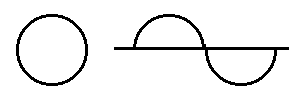
The Circle of Eternity and the Cycle of Time
Figure 3
Geometrically, a cycle emerges out of a circle by a simple change of direction from clockwise to counterclockwise at the half-way point. (Figure 4a-b) But a cycle becomes more interesting when divided into quarters, as shown in Figure 4c, and even more so when the quarter-circles are rearranged as in Figure 4d. Here the first quarter of the cycle begins from the ascended position, changes direction from clockwise to counterclockwise for the second and third quarters, then reverses again for the fourth and final-quarter ascent back to its beginning position. By this four-fold change of directions from clockwise to counterclockwise and from descending to ascending, the progression is a swooping descending/ascending movement from higher dimensions of awareness to ordinary, everyday terra firma and back again—a sequential pattern recorded in the Gospels as the Annunciation, Incarnation, Crucifixion, Resurrection and Ascension.
|
|
||
|
The Geometric Progression of a Descending/Ascending
Cycle
|
||
|
The same descending/ascending cycle also corresponds to the dynamic movement evident in the arrangement of the Hebrew letter/numbers spelling out Abba. (Figure 5) Here the quarter-cycles correspond to the descent of the One as "A" who becomes the two—B/B—who then returns to the One, the "A." |
||
The Four Movements of the
Descending/Ascending A B B A Cycle |
Power to Become
Thus Abba, in the language of graphics, corresponds to the opening message of John's Gospel:
In the beginning was the Word,
and the Word was with God,
and the Word was God.
And the Word became flesh
and dwelt among us,
full of grace and truth.
[. . . and to all who could receive it]
was given the power to become
the children of God.
╬ ╬ ╬
2 Galatians 3:27
3 1 Corinthians 2:16; Philippians 2:5
4 Colossians 1:27
5 C G Jung, Aion, C W 9 Part II, Bollinger Series, Pantheon, NY, Princeton Univ, NJ, 1959, p 37
6 2 Corinthians 12:2
7 Edward F Edinger, The Mysterium Lectures, Inner City Books, Toronto, 1995, p 55
8 Matthew 16
9 Matthew 7: 7-8
10 Carlos Suaras, The Second Coming of Reb Yhshwh, Samuel Weiser, Inc, NY, 1994, p. 187
11 Ibid, p 204
12 Ibid, p 186
13 Matthew 16:25
14 C G Jung, Psychology and Religion, CW 11 par. 233.
15 Teilhard de Chardin, The Heart of Matter, Harcourt Brace, San Diego, 1978, p35
16 Bhagavad-Gita, Prabhavananda, Isherwood translation, New American Library, 1954, p 100
17 Matthew 3:2; Luke 17:21
18 Matthew 5:17
19 Suares, op cit, p xi
Go To Chapter I
Return to Higher Ground Home
Return to Murraycreek Homepage


